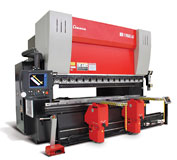Down acting brakes are by far the most common type of press brake in the industry today. The operate on the basic principle that the upper beam holds the punch and is lowered into the die. Almost all mechanical press brakes are down acting types. This tends to be an intuitive design for new operators.

Pros:
- Because the lower beam is fixed it is easier for the operator to hold the workpiece against the back gauge while bending, improving accuracy. This means that until the punch engages the top of the sheet metal the work piece does not need to move.
- More ergonomic for the operator because they don’t need to move with the piece, makes it easier to support the piece as its being bent. This can be significant when handling larger work pieces where the operator is standing further back from the machine.
- It tends to be more intuitive for new operators to understand that the upper beam is going to come down, rather than the bottom beam be raised.
- It is less technically difficult to automate up acting press brakes with robotics because the robot only needs to move with the bending of the work piece, rather than moving vertically with the tooling.
Cons:
- Since the ram hangs on the cam instead of sitting on it, as the bearings and cam wear down the motion and tonnage of the ram may vary when bending affecting quality. While this fact may seem minor, the durability of the drive cams and the vibration caused by it wearing down is one of the primary arguments against down acting brakes.
- While less common with modern brakes a mechanical failure would cause the upper beam to close. Even under no additional tonnage the weight of an upper beam can cause significant injury to an operator.